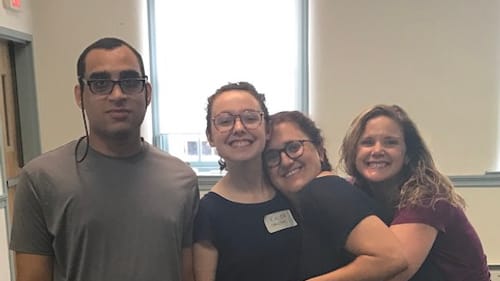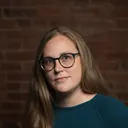Stay in the Loop
BSR publishes on a weekly schedule, with an email newsletter every Wednesday and Thursday morning. There’s no paywall, and subscribing is always free.
Inclusion for you (and everyone else)
Disability Inclusion Workshop for Artists

What if those fidget spinners could be more than this year’s gadget fad?
If we pay attention, said leaders of a disability inclusion workshop for artists, we might notice accommodations for all kinds of people are already here: Assistive listening devices are common at theaters; many classrooms let kids balance their restless behinds on flexible ball chairs; nobody thinks twice when museums offer audio tours in different languages.
Theater artist Tenara Calem, helming the workshop with fellow theater-maker Krista Thorp, noted that the ubiquitous spinners could be a new access point to activities for people who need extra sensory input to focus.
Workshop co-leader Lisa Wallace-Larkin agreed. She’s an “inclusion specialist” at the Arc of Philadelphia, an organization whose mission is to “advocate with and for all children and adults with intellectual and developmental disabilities and their families, to promote active citizenship, self-determination, and full inclusion.” Arc youth liaison William Del Toro Vargas also helped lead the event.
“Natural ambassadors for inclusion”
The July 22 workshop grew out of Calem’s solo show, Me, More Normal (directed by Thorp), which premiered in June and returns for the 2017 Fringe. Crowdfunding for the production, which explores Calem’s life with a brother who has autism, exceeded its goal. The artists decided to expand the mission of the show by teaming with Arc to lead a workshop focused on producing inclusive art.
About 15 people joined the event’s discussions and activities, including outwardly able-bodied and neurotypical artists and educators and people with a range of disabilities. “Inclusion is not a thing. It’s a mindset,” Wallace-Larkin said. And their creativity makes artists “natural ambassadors for inclusion.”
Calem wanted participants to ponder two things: How can we make our own inclusive artistic spaces? And how can we encourage existing institutions to adapt or create theirs?
Universal Design
Part of the answer is Universal Design for Learning (UDL), said Wallace-Larkin. To demonstrate, she displayed her young son’s shoe, a black-and-red high-topped sneaker with Velcro straps instead of laces. “This is not a shoe for a child with a disability. It’s a shoe for everyone,” she said. Another common example of UDL is an entry ramp: They’re not just for people who use wheelchairs or other assistive devices. Anyone can take the ramp, including folks whose joints need a break, parents with strollers, and everyone else.
At the start of the workshop, participants introduced themselves in classic theater-group style, imitating sounds and/or gestures en masse around the circle. Then, workshop leaders asked participants (on wheels, crutches, or their feet) to move to one side of the room or the other to demonstrate their agreement or disagreement with phrases like “people understand me easily when I talk,” “I can ride public transit easily,” or “I am comfortable in crowded public spaces.”
It was hard to predict who would move where, and the most interesting takeaway was that all abilities (physical, intellectual, social) fall somewhere on a spectrum, regardless of one’s outward appearance.
Not a theoretical problem
Later, a discussion on the lack of representation of people with disabilities in film and stage roles took on the tendency to cast able-bodied actors in these roles. Workshop leaders gently pointed out the gap between the privilege of philosophical questioning and the real-life erasure of many artists.

One attendee wanted to know if disabled actors take precedence in roles written as disabled characters; if so, does that mean a white, able-bodied, cisgender man should play only white, able-bodied, cisgender men? For the sake of freedom in art making, can he inhabit any kind of character he wants?
But there’s hardly a shortage of roles for white, able-bodied, cisgender men and, as Thorp pointed out, folks who fit that description currently can and do play almost anyone. Conversely, nonwhite, non-able-bodied, non-cis people will almost always be required to play a role explicitly matching their bodies. “We have a resource problem we need to address” before we solve the broader questions of who can play whom, Calem said.
“Not as hard as we think it is”
The workshop concluded with attendees collaborating in groups to brainstorm an art piece featuring UDL — that is, not just something that could accommodate for a range of people but something with at least one aspect anyone could enjoy unaided. Two groups conceived interactive performance pieces, and the group I participated in made paper mockups of a sculptural installation of intersecting tubes. The tubes had coloring and patterns audiences could see, sounds that could echo, structures to pass through, and textures to feel. “It’s hard, but not as hard as we think it is,” Wallace-Larkin said of thinking inclusively.
How about, Calem added, we view the current art world’s “multimedia” buzzword as another phrase for Universal Design — i.e., one work with aspects that appeal to different perceptions and abilities?
Thorp noted that another theme to emerge from the collaborative activity was the role that site-specific performance could play in UDL within the arts. When you enter a site-specific piece (like an outdoor performance site), there’s naturally a wealth of sensory input accessible to a range of people. It’s a setting that would be much harder to evoke though stage design tailored only to people who can see or hear and who can tolerate sitting in rows in a crowded, darkened room.
An inclusive mindset expands and improves artwork instead of limiting it, Thorp said. “When you make it accessible for more people, it’s just better.”
“I continue to be blown away by people’s interest and support of what we’re doing,” Calem concluded. “I’m hoping it can mobilize other artists to push against the exclusivity of our artistic spaces.”
What, When, Where
Disability inclusion workshop for artists. Tenara Calem, Krista Thorp, Lisa Wallace-Larkin, and William Del Toro Vargas. July 22, 2017, at the Germantown Mennonite Church, 21 W. Washington Lane, Philadelphia. (215) 843-5599 or germantownmennonite.org.
Sign up for our newsletter
All of the week's new articles, all in one place. Sign up for the free weekly BSR newsletters, and don't miss a conversation.

 Alaina Johns
Alaina Johns